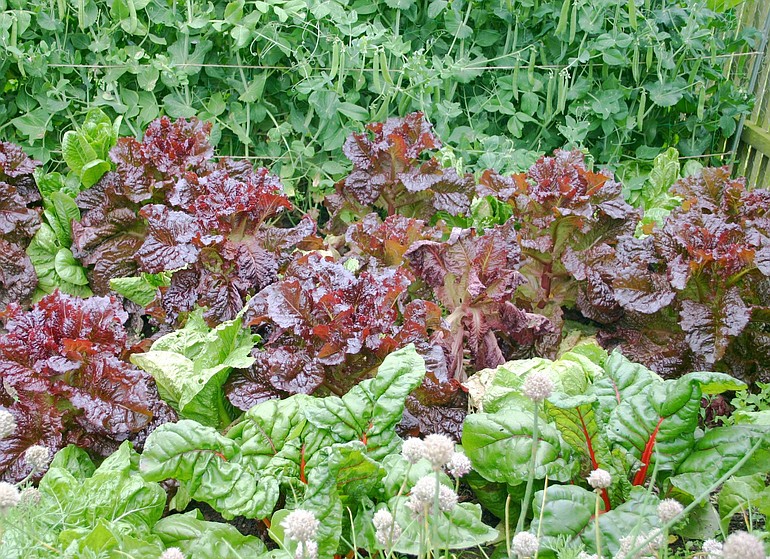For those of you who share your garden with cats, I suggest you plant a stand of Catnip (Nepeta cataria) in the herb bed this year. It is well known for its effect on cats. What fun it is to watch little Miss Priss roll around in a rapturous, undignified frenzy. Catnip tends to have a sedative effect on humans when drunk as a tea.
Catnip is a perennial herb, a member of the Mint family, Labiatae. Any gardener with a passion for cooking — and the only thing better than one passion is having two that complement each other — should have a plot of herbs, onions, garlics and peppers. Using fresh herbs from your own garden will raise the level of flavor in any recipe.
Back in vogue
Years ago, whenever I mentioned that I was a gardener, people would invariably ask me what vegetables I liked to grow. At the time, I had never grown vegetables, instead concentrating on plants with the purpose of landscaping. Now it appears that the trend for growing vegetables has returned to the American garden.
If you want to include a small plot of vegetables in your garden this year, here are a few details to keep in mind:
o Vegetables need plenty of sunshine for superlative growth. Most vegetables require at least six hours of full sunshine to do extremely well.
o Plant vegetables in a wind-free area. Water plays an important role in the success of vegetables, and wind can be dehydrating and increase the plants’ water needs.
o Run rows of vegetable plants in a north to south alignment so the plants don’t shade each other and each plant receives an even amount of sunlight as the sun moves from east to west.
o You can save money by planting seed, but give yourself an easy head start the first couple of years of vegetable gardening by planting out healthy, well-grown transplants.
o Keep your first veggie garden to a reasonable size. Next year you can expand if you find you want more plants.
There are many reasons for a homeowner to grow a vegetable garden. Once you have tasted homegrown vegetables, you know that flavor alone is a viable reason to put in the effort. Growing vegetables as a family brings us closer together. Let each member of your group pick their favorite fruit or veggie to grow, and share the preparation, upkeep and bounty of everyone’s efforts. Nothing unites two, three, or more people as well as a shared purpose.
Matched perennials
Working together is also an important theme for successful shopping trips. To be sure that you choose compatible garden perennials and to avoid expensive mistakes, here are a few tips to match flowering plants at the nursery or garden center before purchasing:
o Arrange plants on a nursery cart to see which ones work well together. Pay attention to leaf texture and color. Consider contrast and repetition. Try bold next to delicate and big next to small. Contrast flower shapes as well.
o Pair flowers for color. Mix, match or contrast hot, summer colors (Red, orange, and yellow) with cool, spring-like colors (Blue, lavender, peach, and pale pink). Separate clashing colors with blue or white flowers or gray foliage.
o Check plant tags to be sure of each plant’s growing requirements. How big will the plant grow and what degree of sun or shade do they need to thrive? Plant perennials that have similar needs together.
o Choose plants that will bloom at the same time. To prolong the bloom season, include early and late bloomers. For example, choose two or three great plant combinations for each season of the year.
o Consider plant size. Gallon-sized perennials (6-inch pots) have more immediate impact when planted in the garden than smaller stock, but they are more expensive. Buy smaller plants (4-inch pots) for container planting. Pack several plants closely together and fertilize often for a full display.
o Check plant health. Avoid buying plants that are tall and leggy. Pull the plant a couple of inches out of the container to see if roots are compacted or root-bound. Choose full plants with healthy-looking roots.
One of my favorite perennial plants is the hybrid bleeding heart Dicentra x ‘King of Hearts,’ with clusters of bright, rose-pink, heart-shaped flowers over delicately textured, blue-green foliage.
Be sure to pluck an individual bleeding heart flower from a plant, turn it upside down and carefully pull the two halves of the heart apart to reveal a naked, ivory white “lady in a bathtub.” This is one early garden lesson I never forgot.
Robb Rosser is a WSU-certified Master Gardener. Reach him at Write2Robb@aol.com.



